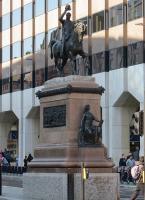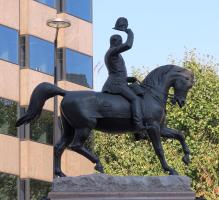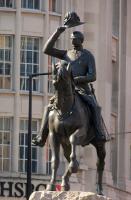


Prince Albert at Holborn, by Charles Bacon.
Prince Albert at Holborn, by Charles Bacon.


North of Fleet Street runs High Holborn to Chancery Lane, and thence to Holborn Circus, just before Holborn Viaduct crosses Farringdon Road and takes us through to the north side of St Paul’s Cathedral. Just off the Circus is an equestrian statue of Prince Albert, unusually shown in a jaunty pose raising his hat, as if in salute to a long-gone cheering audience. The statue is raised on a tall, solid plinth of red granite, on the sides of which are relief panels, and to the front and back of which sit allegorical girls. They looked rather grim with peeling paint until fairly recently, 2014, when they were nicely renovated and repainted black, and now look excellent.
The figure of Albert shows him in military uniform – as a Field-Marshall apparently – with upturned stiff collar and several decorative medals. He is readily recognisable, whiskered, sideburned and bald, but a typical portrait rather than a characterful one.
The panels are entitled ‘The Prince laying the first stone of the Royal Exchange, Jan 17, 1842’, and ‘Exhibition of All Nations, 1851, Britannia distributing awards’. Both show a large number of standing figures. The 1842 scene is reminiscent of Byzantine pictures, with many more heads than bodies and feet, as the dignitaries gather round a small crane with a block. Rather an unsatisfactory piece. The 1851 (Great Exhibition) one is better, with Britannia seated centrally within a surround of twisted cloths, arms outward to either side, fairly symmetrically, presenting the awards to the kneeling figures of an oriental gentleman on one side, and a turbaned one on the other; behind them are the peoples of all nations, with a variety of gestures, accoutrements and something of a unity to each flank. Britannia herself has her usual shield and trident, and in front of her, a seated lion (for more statues of Britannia, see this page).
The two allegorical girls are labelled History and Peace. History holds a book and a quill pen to write her story in it (the quill is not original). She has long hair, rather curly, and her face is ideal Victorian rather than Classical. She is wearing the usual Greek attire, heavier over the legs, lighter above, and off one shoulder to leave arm and breast exposed. Her sister, Peace, holds an olive branch in one hand, though the leaves are rather long and limp, and with the other supports a Cornucopia, or horn of plenty. She is similarly draped, but with her top open rather than pulled down; her physique, so far as we can see it, is rather muscular. The outstanding feature of this figure is her head, again with Victorian roundness rather than Greek severity, but with symmetrically spread locks of hair and a crowning wreath which gives her an exotic look, almost as if she was wearing some headdress.
The statue was put up in 1874, thus rather after the death of Prince Albert, and the sculptor was the rather obscure Charles Bacon. No relation apparently of the far better-known father and son, John Bacon Senior and John Bacon Junior, Charles Bacon (c.1821-c.1885) was firstly a modeller of seals, medallions and gems, and only later sculpture, and many of his exhibited works during his lifetime were carvings on the miniature scale. The Prince Albert at Holborn is by far and away his most important work; other portrait statues include an earlier equestrian group, with the tipping of the hat gesture, to John Erle Drax at a place called Olantigh Towers, in Wye in Kent; a statue of the explorer, John Franklin (he who discovered the North West Passage) at his birthplace of Spilsby, near Skegness in Licolnshire; and a statue of John Candlish, MP for Sunderland. None of these are particularly exciting. Although he exhibited a number of allegorical works, including an interesting-sounding Helen Veiled before Paris, these seem by and large to have vanished – perhaps they were in plaster – and we are lucky that the pair of allegorical girls on the Albert monument give an indication of his style for this sort of work.
We may note that there are other interesting sculptural things nearby: the Prudential with its war memorials a few moments to the west (see this page), St Andrew Holborn on the corner, with the tomb of Captain Thomas Coram, and carrying on past that church, Holborn Viaduct (see this page) and thence to Old Bailey. Alternatively, there are interesting bits of architectural sculpture along Hatton Garden to the north, or the visitor may head south to Fleet Street.
Sculptors // Sculpture in London
Visits to this page from 4 Oct 2015: 9,258